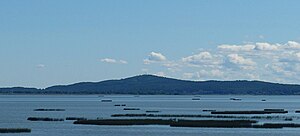Rowokół
| Rowokół | ||
|---|---|---|
| height | 115 m npm | |
| location | Pomeranian Voivodeship , Poland | |
| Mountains | Baltic ridge | |
| Coordinates | 54 ° 39 '23 " N , 17 ° 12' 36" E | |
|
|
||

The Rowokół ( [rɔˈvɔkuː] , German Revekol , 115 m npm ) is an elevation in the Polish Pomeranian Voivodeship .
geography
The Rowokół is located in the east of Pomerania , in Western Pomerania , between the Jezioro Gardno (Lake Garda ) and the Łebsko ( Lake Lebasee) . In the northeast of the mountain is the village of Smołdzino (Schmolsin) , in the southwest of the village of Gardna Wielka (Great Guard) . In the east and north the mountain is surrounded by the river Łupawa (Lupow) .
From a geological point of view, the Rowokół can be classified as a compression moraine hill . It is part of an elongated coastal ridge.
The Rowokół hill is 115 meters behind the Pieczek (Pietschker Berg) with 181 meters high, the second largest elevation in the area of the former Stolp district .
history
The origin of the name Revekol is not clear. It is believed that it was derived from the Latin term reverendus collis (venerable mountain). Another variant is Rowes Höhe , after the nearby town Rowe and the Danish word kull (height). In some older texts, the name Revekol was conjured up as Räuberkuhle .
In the Middle Ages, there was a Lady Chapel on the Revekol. Numerous pilgrimages were made there before the Reformation - as was also the case in Western Pomerania at the time to an allegedly miraculous image of Mary in the Marienkapelle on Gollenberg further west and to the so-called St. Berg near Pollnow . The Revekol with its chapel was in the Middle Ages not only an important place of pilgrimage , but it also served to sailors on the Baltic Sea in the navigation as navigational aids . According to a sea book from the second half of the 15th century, ships sailing from Bornholm to Prussia first headed for the Revekol and were able to use Lake Gard as a port of refuge.
In the course of the Reformation , the chapel was closed, probably in connection with the Stolper iconoclasm in 1525. It was demolished before 1535. Because of the silting up of the coast at this time, Lake Gard could no longer be used as a port of refuge and therefore the chapel was no longer required as a navigation mark. The remains of the chapel above ground were removed in 1821, the foundations in 1837 and used as building material. A lookout tower was later built on the Revekol.
literature
- Johannes Hinz: Pomerania. Dictionary. Flechsig, Würzburg 2001, ISBN 3-88189-394-6 .
- Johannes Hinz: Pomerania guide through an unforgettable country . Adam Kraft, Würzburg 1991, ISBN 3-8083-1195-9 , p. 295.
Individual evidence
- ↑ C. Wolff: Characteristics of the surface shape of Hinterpommern from the Gollenberge to the east . In: Baltic Studies . Volume 6, 1st issue, Stettin 1838, pp. 172-182, especially p. 180.
- ↑ Paul Pollex: The place names of Virchenzin and the surrounding area ( Memento of the original from November 26, 2015 in the Internet Archive ) Info: The archive link has been inserted automatically and has not yet been checked. Please check the original and archive link according to the instructions and then remove this notice. . In: Ostpommersche Heimat . No. 19, 1933
- ↑ Christian Friedrich Wutstrack , Ed .: Short historical-geographical-statistical description of the royal Prussian duchy of Vorpommern and Hinterpommern . Stettin 1793, p. 755.
- ↑ a b c Ernst Bahr, Klaus Conrad: Revekol . In: Helge bei der Wieden , Roderich Schmidt (Hrsg.): Handbook of the historical sites of Germany . Volume 12: Mecklenburg / Pomerania (= Kröner's pocket edition . Volume 315). Kröner, Stuttgart 1996, ISBN 3-520-31501-7 , pp. 260-261.
- ↑ Ludwig Wilhelm Brüggemann : Detailed description of the current state of the Königl. Prussian Duchy of Western and Western Pomerania . Part II, Volume 2, Stettin 1784, p. 911.

